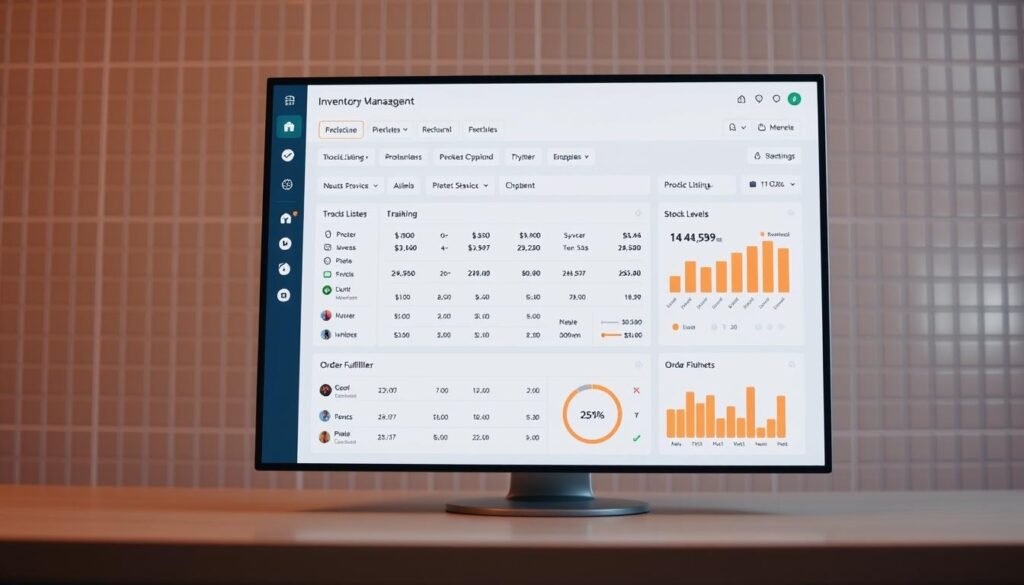Address
304 North Cardinal
St. Dorchester Center, MA 02124
Work Hours
Monday to Friday: 7AM - 7PM
Weekend: 10AM - 5PM
Address
304 North Cardinal
St. Dorchester Center, MA 02124
Work Hours
Monday to Friday: 7AM - 7PM
Weekend: 10AM - 5PM

Are you finding it hard to keep track of your stock? This can lead to lost sales and too much stock. Good inventory management is key for any online business to do well.
Handling your online inventory well can seem tough. But, the right inventory management software can make it easier. It helps you manage your stock better, saving costs and making customers happier.
Knowing how important inventory management is and using the right tools can really help. In this article, we’ll look at different ways to manage your online inventory better.
Online inventory management is key for any e-commerce success. It makes sure products are ready when customers want them. It covers managing stock, tracking orders, and adjusting inventory to meet demand well.
Inventory control is vital in online management. It uses inventory control tools to watch stock, track products, and avoid too much or too little stock. Good control cuts costs, boosts customer happiness, and keeps businesses ahead.
With a strong control system, businesses can have the right products at the right time. This makes customers happy with quick deliveries and saves money on holding too much stock.
Online inventory management faces challenges like stockouts, too much stock, and wrong records. Stockouts can lose sales and hurt trust, while too much stock wastes money. Wrong records cause confusion and make managing stock hard.
To beat these problems, businesses should use an online inventory management system for real-time tracking, reports, and alerts for low stock. This helps make smart choices, manage stock better, and run operations smoothly.
Knowing how important inventory control is and the common problems helps businesses start solving these issues. This knowledge lets them pick the best tools and systems for managing inventory well. It leads to happier customers and more profit.
To manage your inventory well, you need tools with various features. These include tracking and multi-channel integration. When picking an inventory management tool, look for key features that fit your business needs.
![]()
Real-time tracking is key. It lets you watch your stock levels as they change. This keeps you updated on your inventory, helping you make quick decisions. With real-time tracking, you can:
Multi-channel integration is also crucial. It lets you manage your inventory on different sales channels, like your website, Amazon, and eBay, from one place. This integration helps in:
By adding these features, digital inventory management tools can greatly enhance your inventory management. This makes it easier to fulfill orders and keep your customers happy.
Businesses have many choices for inventory management software. Options like Shopify and TradeGecko are popular. The right tool can greatly improve your business’s efficiency and profits.
Shopify is a well-known e-commerce platform with strong inventory management features. It’s great for businesses using Shopify for their online stores. You can track inventory levels across different places, set up automatic reorder notifications, and manage your stock well.
Square is a top choice for businesses needing strong point-of-sale and inventory management. Its tool lets you track stock levels in real-time, manage inventory across different places, and keep stock levels in sync across sales channels.
TradeGecko is a detailed inventory management solution for growing businesses. It has advanced features like forecasting and reporting for better decision-making. With TradeGecko, you can automate inventory management, streamline operations, and boost your business’s performance.
When picking between these options, think about your business’s needs. Consider the size of your inventory, the complexity of your supply chain, and your budget for inventory management software.
Inventory management tools bring many benefits to your business. They automate and streamline tasks, making your operations more efficient and saving costs.
Using inventory management tools boosts your efficiency. They automate tasks like tracking inventory and updating stock levels. This reduces errors caused by humans. With inventory optimization software, your stock levels stay current, making operations smoother.
Good inventory management improves customer satisfaction. It ensures products are in stock and orders are delivered on time. Inventory tracking software lets you check stock levels live. This helps manage customer expectations and keep promises.
These tools give you insights into your inventory, sales, and product performance. This data helps you make smart inventory decisions. You can spot top-selling items, set the right stock levels, and plan for future demand. With the right data, you can better meet customer needs.
Let’s look at the benefits with an example:
| Benefit | Without Inventory Management Tools | With Inventory Management Tools |
|---|---|---|
| Efficiency | Manual tracking, prone to errors | Automated tracking, reduced errors |
| Customer Satisfaction | Stockouts and delayed orders | Timely order fulfillment, improved customer experience |
| Decision-Making | Limited insights, based on historical data | Real-time data, informed decisions |
Adopting inventory management tools can greatly improve your business. It leads to better performance and happier customers.
Finding the right inventory management tool can really boost your business. But, how do you pick the best one? It’s all about knowing what your business needs and what each tool offers.
First, figure out what your business needs. Think about the products you sell, how much you sell, and any special needs. For example, if you sell perishable items, you’ll need a tool that tracks expiration dates.
Key considerations include:
Cost is also key. Inventory tools vary in price. You should find one that fits your budget but still meets your needs. Look at the upfront cost and any monthly fees.
| Tool | Initial Cost | Monthly Subscription |
|---|---|---|
| Tool A | £500 | £50 |
| Tool B | £0 | £30 |
| Tool C | £1000 | £80 |
Think about how the tool will grow with your business. Your needs might change as your business grows. Pick a tool that can grow with you, offering more features and support when needed.
Scalability features to look for:

By looking at your business needs, budget, and growth plans, you can find the perfect inventory tool. It will make your business more efficient and help it succeed in the long run.
To get the most out of your inventory management system, linking it with other business software is key. This makes your operations smoother, cuts down on mistakes, and boosts efficiency.
Integrating your inventory management software with other apps automates tasks and keeps data flowing smoothly. It saves time and makes your data more accurate.
Connecting your online inventory management system with accounting and finance software is vital. It keeps your financial data in sync with your stock levels, ensuring your accounts are always current.
Linking your inventory tool with accounting software automates invoicing, expense tracking, and financial reports. It lightens the load on your team and cuts down on financial errors.
Another important link is with e-commerce platforms. By tying your inventory system to your online shop, you manage stock and sales in one place.
This connection lets you update listings, track orders, and manage stock in real-time. It ensures customers get accurate info on product availability.
Also, linking your inventory software with e-commerce platforms helps spot trends. This guides your decisions on what products to offer and how much to stock.
To get the most out of your inventory management tool, following best practices is key. This ensures your inventory control is both efficient and effective.
![]()
Regular audits are crucial for keeping inventory records accurate. They help spot any issues and make the needed changes. This prevents stockouts or overstocking, as an expert pointed out.
« Regular inventory audits help businesses avoid costly mistakes and improve their overall inventory management, » they said.
Having the right product information is essential for correct customer orders. This includes keeping product descriptions, prices, and stock levels up to date. Using effective inventory tracking tools helps achieve this accuracy.
Setting reorder points is vital for inventory management. It lets you automatically order more when stock levels hit a certain point. This avoids stockouts and is a key part of using inventory control tools well.
By following these best practices, you can greatly improve your inventory management. This leads to happier customers, lower costs, and a strong market position. « The key to successful inventory management lies in adopting the right strategies and tools, » a leading business publication noted.
Using advanced inventory management software can make your inventory processes smoother. These tools offer many features that can really help your business run better.
Analytics and reporting are key features. Digital inventory management tools give you insights into how your inventory is doing. This lets you make smart choices. With detailed reports, you can spot trends, track sales, and adjust your stock levels.

Demand forecasting is crucial for predicting what customers will want in the future. Inventory optimisation software uses past sales and market trends to forecast demand. This lets you adjust your stock levels before it’s too late.
This feature is great for:
Automated order management makes fulfilling orders easier. It automates tasks like processing orders and sending shipping updates. This cuts down on mistakes and makes customers happier.
The perks of automated order management are:
Mobile apps have changed how we manage inventory. They let businesses manage stock anywhere, anytime. You can check your inventory data from your mobile device, no matter where you are.
Mobile apps are great because you can access your inventory data from anywhere. You can see stock levels, track orders, and manage inventory in real-time. This is useful whether you’re in the warehouse, on the shop floor, or at a meeting.
Key benefits of mobile accessibility include:
Many mobile inventory apps have barcode scanning. This makes tracking inventory easy. By scanning barcodes, you can quickly update stock levels and track product movement. It also helps reduce manual errors.
The benefits of barcode scanning include:
To show how good mobile apps are for inventory management, let’s compare them to traditional methods:
| Feature | Traditional Method | Mobile App Method |
|---|---|---|
| Accessibility | Limited to desktop or specific terminals | Accessible from anywhere using mobile devices |
| Inventory Tracking | Manual entry or limited barcode scanning | Advanced barcode scanning and real-time tracking |
| Data Analysis | Delayed reporting and analysis | Real-time data analysis and reporting |
Looking at successful inventory management shows us its benefits and challenges. Companies in different fields have seen big gains by using good inventory tools.
In retail, managing stock is key to keeping customers happy. A UK retailer cut stockouts by 25% and sales by 15% with a new system.
« The right inventory management tool has transformed our ability to meet customer demand while minimizing waste. » –
The system helped the retailer track stock in real-time and order more automatically. This made things run smoother and kept customers happy by having what they wanted.
| Retailer | Pre-Implementation Stockouts | Post-Implementation Stockouts | Sales Increase |
|---|---|---|---|
| UK Retailer | 15% | 5% | 12% |
| US Retailer | 20% | 8% | 10% |
E-commerce has also seen big wins with inventory software. An online shop cut costs by 30% with a cloud-based system.
The system let the shop keep stock levels in sync across all platforms. This cut down on overselling and made customers happier.
By choosing the right inventory tools, both retail and e-commerce can do better. They can serve customers better and save money.
The world of inventory management is changing fast. New technologies and business needs are driving these changes. It’s important to know what’s coming next in this field.
Artificial intelligence (AI) and machine learning (ML) are making inventory management smarter. They help predict needs and make decisions automatically. These tools will keep improving how we manage and organise inventory.
Nowadays, being green is key in inventory management. Companies want to cut down on waste and use eco-friendly methods. This not only helps the planet but also saves money.
Looking ahead, using new tech and green practices will be crucial. Digital tools and smart inventory systems can make your business more efficient. This leads to lower costs and happier customers.
Inventory management software is a digital tool. It helps businesses track and manage their stock levels. It also organises orders and sales across different sales channels.
First, identify what your business needs. Then, think about your budget. Look for a tool that fits your needs and integrates with your systems, like e-commerce and accounting software.
Inventory optimisation software keeps your stock levels just right. It reduces stockouts and overstocking. This improves customer satisfaction by ensuring orders are fulfilled on time and accurately.
Yes, many tools integrate with other software. This includes accounting, e-commerce platforms, and shipping providers. It streamlines your operations and boosts efficiency.
Mobile apps offer on-the-go management. They let you manage your inventory from anywhere. They often include barcode scanning to simplify tracking and reduce errors.
Best practices include regular audits and accurate product information. Set reorder points to keep your records accurate and prevent stockouts.
AI and machine learning enhance inventory management. They improve demand forecasting and automate decisions. This optimises stock levels and keeps you competitive.
Digital tools are key in e-commerce. They help manage online inventory, track orders, and ensure timely fulfilment of customer orders.
Effective tools ensure accurate and timely order fulfilment. This reduces stockouts and backorders, improving customer satisfaction.
Look at the tool’s ability to categorise and track inventory. Consider its ease of use and integration with your systems.
Yes, it can. Inventory management software minimises stockouts, overstocking, and errors. It optimises inventory levels to meet demand, reducing costs.